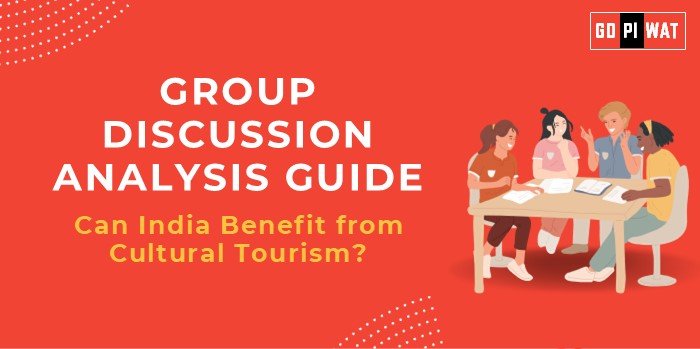📋 Group Discussion Analysis Guide: Can India Benefit from Cultural Tourism?
🌐 Introduction to Cultural Tourism in India
- 📜 Opening Context: India, with its rich tapestry of traditions, historical landmarks, and diverse cultures, is a natural hub for cultural tourism. Globally, cultural tourism contributes significantly to economic and social development, making it highly relevant for India’s growth narrative.
- 📖 Topic Background: Cultural tourism involves traveling to experience the heritage, arts, and lifestyle of a destination. India boasts over 40 UNESCO World Heritage Sites, vibrant festivals, and unique art forms, presenting immense opportunities for leveraging cultural tourism.
📊 Quick Facts and Key Statistics
- 🏛️ UNESCO World Heritage Sites: 40+ in India, showcasing the nation’s historical and cultural wealth.
- 💰 Contribution to GDP: Tourism contributed approximately 5% to India’s GDP in 2023.
- 👩💼 Employment: The tourism sector supports over 87 million jobs, with cultural tourism forming a major subset.
- 🌍 Global Ranking: India ranks among the top 10 countries for heritage tourism.
- 📈 Growth Potential: Expected CAGR of 8% in tourism revenue by 2025.
👥 Stakeholders and Their Roles
- 🏛️ Government: Policy-making, infrastructure development, and promotion of cultural tourism (e.g., Incredible India campaign).
- 💼 Private Sector: Investment in heritage hotels, guided tours, and local businesses.
- 🏘️ Local Communities: Preserving and promoting cultural heritage while benefiting economically.
- 🌍 International Bodies: UNESCO and WTO promoting heritage conservation and sustainable tourism.
🏆 Achievements and Challenges
✨ Achievements
- 🌟 Enhanced Global Recognition: The “Incredible India” campaign has significantly boosted India’s cultural image worldwide.
- 📈 Increased Tourist Inflows: Over 17 million foreign tourists visited India in 2023, many for cultural experiences.
- 🏛️ Preservation Efforts: Initiatives like “Adopt a Heritage” promote corporate involvement in maintaining heritage sites.
- 💸 Economic Benefits: Rajasthan, a cultural hotspot, reported a 15% rise in tourism revenue in 2023.
⚠️ Challenges
- 🚧 Infrastructure Gaps: Limited connectivity to remote cultural sites.
- 📉 Over-tourism: Heritage sites like the Taj Mahal face wear and tear due to excessive footfall.
- 🤝 Lack of Local Engagement: Insufficient involvement of local communities in tourism benefits.
- 🌍 Global Comparisons: Countries like France and Italy, with comparable heritage resources, generate significantly higher tourism revenue.
Case Studies:
• Rajasthan: Successful promotion of cultural events like the Jaipur Literature Festival.
• Kerala: Integrated cultural experiences with natural tourism, boosting local employment.
📢 Structured Arguments for Discussion
- 💬 Supporting Stance: “Cultural tourism can be India’s economic and cultural bridge to the world, enhancing revenue while preserving heritage.”
- 🗣️ Opposing Stance: “Unregulated cultural tourism risks diluting heritage value and overburdening infrastructure.”
- ⚖️ Balanced Perspective: “While cultural tourism offers immense benefits, addressing sustainability and inclusivity is key to its success.”
📈 Effective Discussion Approaches
- 💡 Opening Approaches:
- Highlight the economic impact of cultural tourism with statistics.
- Begin with a relevant case study, like Rajasthan’s tourism success.
- 💡 Counter-Argument Handling:
- Example: If infrastructure issues are raised, counter with emerging initiatives like smart city integrations.
📊 Strategic Analysis: SWOT Framework
Strengths
- 🏛️ Rich cultural heritage.
- 🌍 Global appeal.
- 📈 Growing domestic interest in heritage preservation.
Weaknesses
- 🚧 Poor site management.
- 📉 Infrastructure deficits.
Opportunities
- 🌐 Integration with digital platforms.
- 🍃 Eco-tourism development.
Threats
- 🌱 Environmental degradation at heritage sites.
- 🌍 Global competition from other cultural tourism hubs.
🎓 Connecting with B-School Applications
- 💡 Real-World Applications:
- Business plans for tourism startups.
- Cultural tourism-focused sustainability projects.
- 💡 Sample Interview Questions:
- “How can cultural tourism bridge India’s urban-rural divide?”
- “What role can technology play in enhancing cultural tourism?”
- 💡 Insights for B-School Students:
- Focus on public-private partnerships for tourism development.
- Analyze sustainable development strategies in cultural tourism.
- Study community-driven tourism models for scalable impact.


